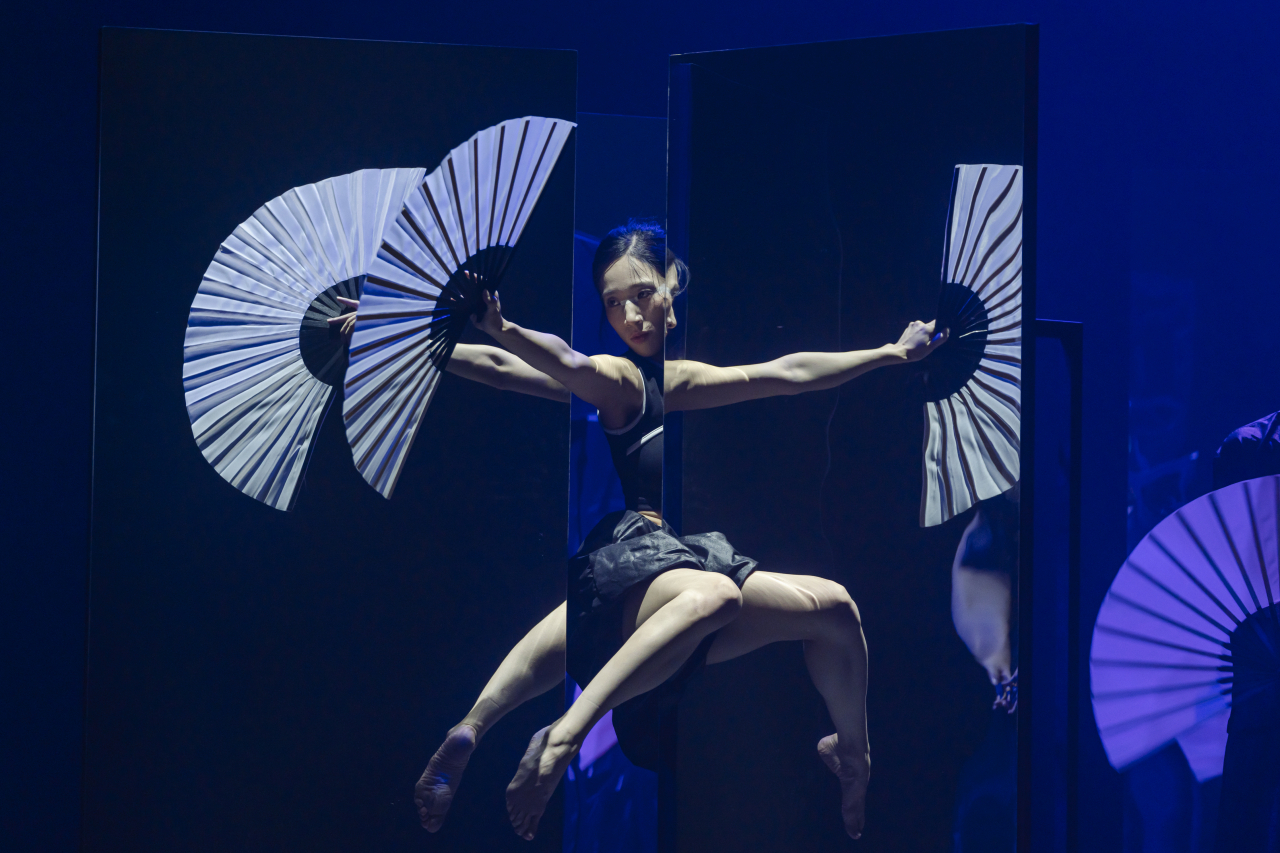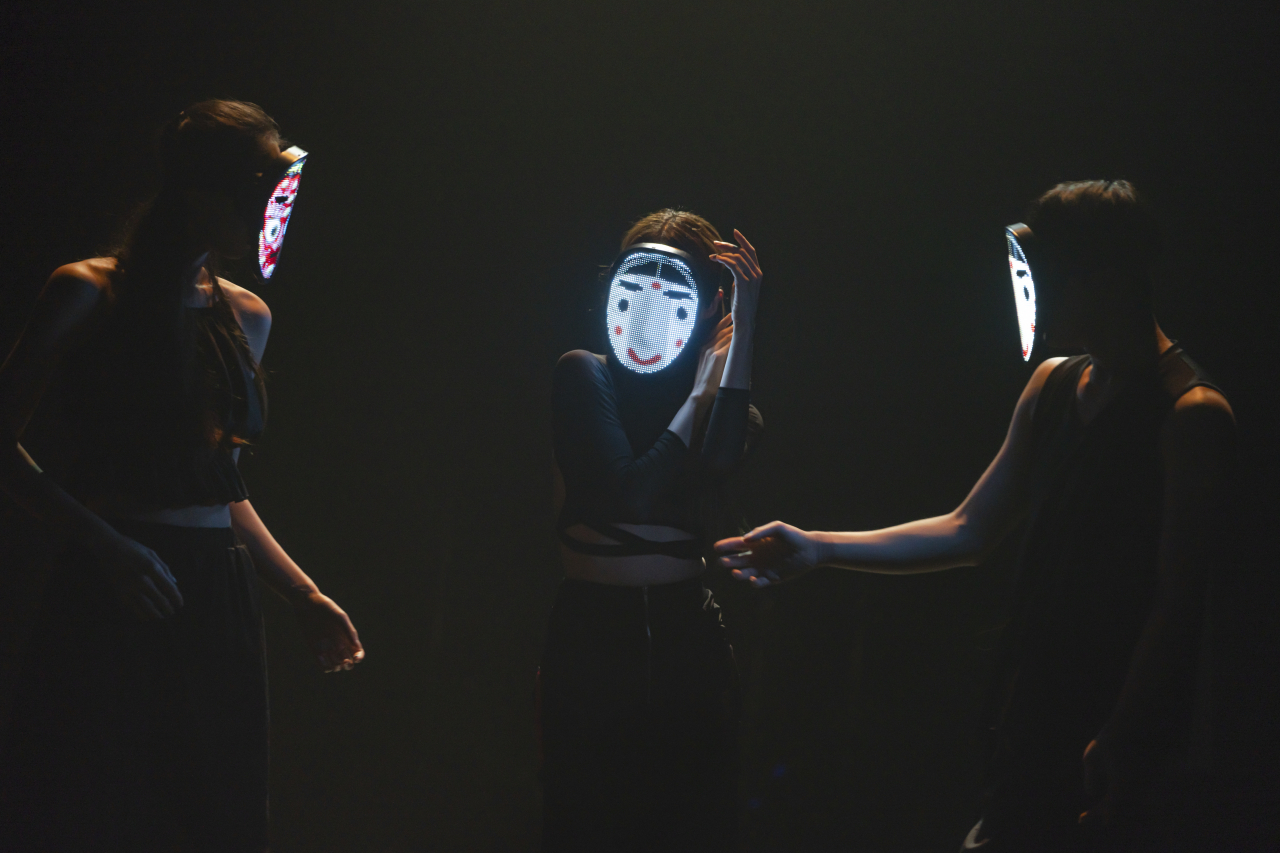 |
"Flick" (National Dance Company of Korea) |
A dancer in a floppy hat and loose, wide-leg pants steps onto the stage, wielding a white fan with remarkable finesse. With deft movements, he conjures an almost magical sequence -- opening and softly folding the fan with a flick of the wrist, each motion seamless and barely perceptible, while his feet shuffle with agility.
Moments later, two more dancers join, positioning their right arms and legs between two tilted mirrors that cast uncanny reflections. Their arms, legs and fans move in harmony, creating layered images that blur the line between reality and virtuality.
The scene is from “Flick,” choreographed by Choi Jong-in, opening the first act of a triple bill, each running 30 minutes. The performance, part of a choreography project by the National Dance Company of Korea, NDCK Project 2024, premiered Thursday at Daloreum Theater.
On the stage surrounded by mirrors, dancers unleashed a forceful energy that reverberated with the metallic clangs and vibrant rhythms of traditional Korean percussion instruments.
 |
Choi Jong-in is seen in this photo during a rehersal for "Flick." (National Dance Company of Korea) |
Choi explained that the choreography draws inspiration from the endless scrolling people do on their smartphones, constantly and mindlessly swiping through short-form content.
"It’s said that it takes just 0.18 seconds to form a positive or negative impression of someone, three seconds to judge a first impression, and that viewers rarely watch YouTube Shorts beyond eight seconds," Choi noted during an open press rehearsal before the premiere.
"Perhaps we’re living in a time where everything is at risk of becoming boring. This piece reflects on people in the here and now, and myself."
 |
A dancer rehearses for “Flick.” (National Dance Company of Korea) |
Each of the seven dancers holds and maneuvers a large mirror, creating an unceasing optical illusion of figures multiplied through light and reflections. This effect captures the blurred line between reality and the surreal world of screens, echoing Choi's concept.
Currently appearing on Mnet’s dance competition program “Stage Fighter,” where dancers from genres including Korean dance, ballet and contemporary dance compete in genre-based battles, Choi is an award-winning choreographer and well-known as the YouTuber Suncapboi.
"My Korean dance is a dance that has to be performed ‘now’ -- one that both the audience and dancers can enjoy naturally, and one that I can share with grandparents who might not be deeply familiar with dance," he said.
Since the show aired, he said he has faced online hate, with comments like, “What kind of dance is this when you're so fat?” and “Why are you even here?”
"I've always felt that I didn’t have the ‘right’ body for Korean dance," said Choi. "But dance isn’t only for the tall and good-looking. I wanted to say, ‘Why not?’ and show that dance isn’t as hard as it might seem, even for someone like me.”
 |
“The Weakness of Silent Existence” (National Dance Company of Korea) |
Alongside Choi, two other choreographers from the NDCK are showcasing their works.
NDCK Head Trainer Jung Gil-man presents “The Weakness of Silent Existence,” a piece that serves as resistance against a society that enforces silence. The performance begins slowly, with each step taken deliberately, unfolding movements that resonate with rhythm while conveying messages through painful and uncomfortable expressions and gestures.
This year, the dancers in NDCK Project are young trainees selected through the Culture Ministry’s youth education training initiative.
For Jung, now in his 50s, this collaboration was an opportunity to explore the differences in perspective between himself and the younger dancers in their 20s.
“I realized that the modern sensibility I was seeking in Korean dance differs from what the younger trainees are looking for. I aimed to weave the differences between generations into the choreography,” said Jung.
 |
“Metamorphosis” (National Dance Company of Korea) |
The third performance features NDCK dancer-choreographer Lee Jae-hwa’s “Metamorphosis.” The title carries a double meaning in Korean, hinting at talchum (mask dance) because it means a switch of masks in Korean.
Lee said that the piece is about breaking free from the stereotypes associated with “Korean-ness.”
The eight dancers start with traditional masks and then put on LED masks that change with a simple touch of the finger, revealing designs that are not strictly traditional.
“I have been thinking about what it means to be ‘Korean.’ I believe that being 'traditional' and being 'Korean' are different. When we are asked to perform Korean dance, we typically think of traditional forms, but I believe we cannot label that as representative of what Korea is today. In this piece, I’ve given a lot of thought to how the genre of Korean dance should evolve over time.”
NDCK Project 2024 runs through Sunday.
 |
“Metamorphosis” (National Dance Company of Korea) |







